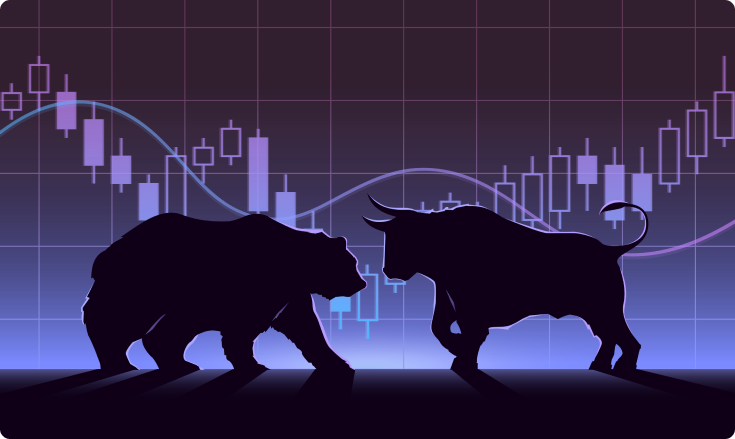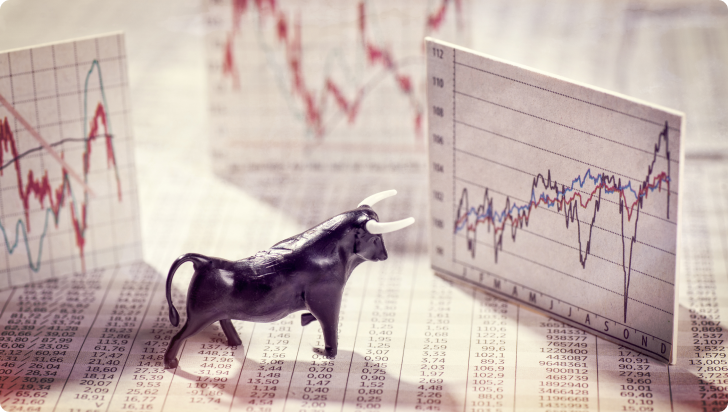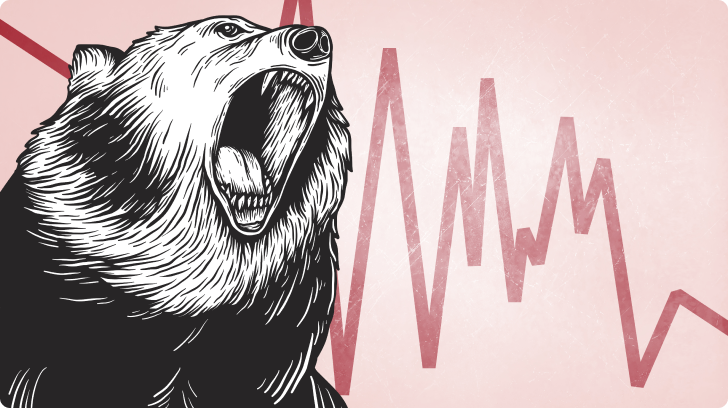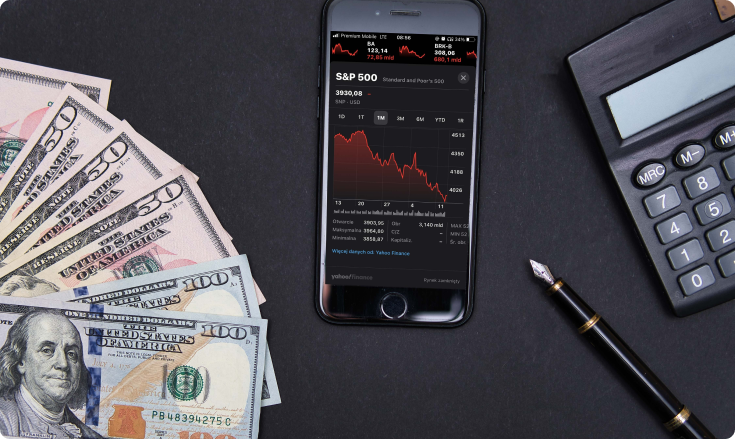What Are Bearish And Bullish Markets?

Two of the animal kingdom’s most fearsome creatures happen to represent the ups and downs of market movements. In this article we listed everythings that you need to know about bulls and bears.
Stock investors, forex traders and those who invest in bonds commonly use terms like bear, bull, bearish and bullish. Both of these terms describe how markets are performing, but they are completely different animals when it comes to the different impact they can have on your portfolio, the investment decisions you make and the overall market. As single expressions they might sound confusing, but you would be impressed by how many times traders use them daily. The explanation of the terms is very simple and it can be extremely helpful when reading financial forecasts and chart analysis.
Bull market, bullish & bulls
In what is known as a “bull market”, the prices are rising and the curve (on the chart) goes up. In this situation, the market is in a long-term uptrend. Or simply, it is defined as a condition in the financial market where the prices are rising or are expected to rise in the future.
Bull markets are most commonly used when we refer to trading stocks but the term also applies to investing in bonds, currencies, real estate and commodities.
The most famous example of a bull market is when a market is experiencing a rise by 20%, but before the growth, a 20% decline was faced. After the period of growth usually another decline of 20% is expected, turning the bull market into a bear one.
The term “bullish” is used to describe an investor’s sentiment. Investors tend to say that they are “bullish” about stocks (for example) when they think that the price of a certain stock will rise.
The “bulls” are people who are optimistic about the price of a certain asset or the market in general. Bulls think that the price will go up and therefore they’re buying an asset so that they can sell it when the price hits a peak. When bulls are the majority in the market, people are investing more money hoping for higher gains and returns.
The famous Charging Bull near Wall Street, made in 1987 by the renowned artist A. Di Modica, represents a market where the economy is thriving.
One of the most notorious bull markets in modern American history started at the end of the stagflation era in 1982 and ended in the 2000. During this period, The Dow Jones Industrial Average (DJIA) brought an average annual returns of 15%
The NASDAQ, increased five times between the period of 1995 and 2000, rising from 1,000 to over 5,000 in value.
Another bull market followed a couple of years after the period of extreme success during the 1982-2000 bull market. In 2009 investors experienced the start of a more than ten-year bull market time period.
Analysts suggest that the start of another bull market happened on March 9, 2009, clearly the technology development and new innovations, technology stocks are the main reason for another bull market.

Bear market, bearish & bears
After a period of rising prices markets tend to shift and experience a downfall. While bull markets are full of positivity, amazing returns and optimystic bulls, bear markets are just the opposite. When prices in the market are going down, we call it a “bear market”. Contrary to a “bull market”, a “bear market” follows a downward trend. Bear markets often happen in periods of economic disasters and during higher unemployment rates.
Instead of wanting to buy into the market, investors want to sell, often choosing safety of cash or fixed-income securities. Bear markets often last for a couple of weeks to several years. The first and most famous bear market was the great depression. It started in 1929 and lasted till 1932.
By October 29, 1929, the Dow Jones Industrial Average had dropped by a shocking number of 30.57%, marking one of the most horrific declines in U.S. history.
The dotcom in 2000 and the housing crisis of 2007–2008 are some other basic examples of a bear market.
But during the financial crises in the period of 2007-2009, the S&P 500 lost 50% of its value. Lasting for about 17 months.
The U.S. major market indices were slowly moving towards a bear market territory on December 24, 2018, after experiencing a 20% downtrend.
Where recently, major indexes including the S&P 500 and Dow Jones Industrial Average (DJIA) fell again into bear market territory between March 11 and March 12, 2020.
Investors with a “bearish” opinion predict that the market or a financial asset will experience a downward trajectory. Investors who believe in a market decline are called “bears”.
“Bears” are rather pessimistic about the economy at a given time and the prosperity of the stock market.
But their opinion is important, because being able to spot and predict a bear market is a key component to being a successful trader, profiting in times like these and stopping extreme loss of capital. To take a bearish position, many traders will short sell. Short-selling is a way of trading that returns a profit if an asset drops in price.
Below we have listed some of the characteristics that a bear market often contains. Analysts and economists look out for these signals in particular. Spotting two or more of these circumstances is a good indication that the economy is entering (or has entered) a bear market.
Characteristics of a bear market:
- Stock prices start to fall.
- Negative investor sentiment. Investors sell current holdings and hold off on buying more shares.
- Economic spending declines, leading to deflation.
- Corporate earnings decrease.
- Higher unemployment levels and cut to research and development.

The origin and meaning of the terms
The origin of the terms “bulls” and “bears” is not entirely known.
There are a couple of theories, and here we will present you with the most popular ones.
The one connected to the London Stock Exchange in the 1600s sounds the most plausible. Back then, info centers had a bulletin board on which investors could post offers to buy a stock. When there were plenty of offers, the board was rich in bulletins, or “bulls”; and when there was a deficiency in offers the board was bare.
Later, these terms changed into “bulls” and “bears”.
Another one, which is mentioned quite often, has to do with how bulls and bears fight. Bulls strike upward with their horns - pushing prices higher, opposite from bears who strike downward with their paws - pushing prices down. It is important to know that investors can decide to be “bullish” in some markets and “bearish” in others. Likewise, they can be “bullish” in the long-term but “bearish” in the short-term.
The third theory is related to a proverb.
This is another theory that suggests the terms originated due to a famous proverb that says it’s not a good idea “to sell the bear’s skin before one has caught the bear.”
Meaning that in the 18th century when middlemen would sell bearskins they didn’t own to buyers for a high price and with and set up a future delivery date. They were speculating with the buyer that the cost price was going to go down.
Once the cost price has declined, they purchase the skin from the bear-catcher for the lower price and deliver it to the buyer meaning they would make a profit
These middlemen were known as “bear-skin jobbers” or just “bear”.
This term went on to be used to describe any stock that was being sold by a speculator.
Investing during Bull and Bear markets
Bull and bear markets are quite different by nature.
By having stocks that are allocated in different types of industries, investors have higher chances of a solid return.
Also, another way to capitalize during an uptrend or a bull market is to buy stocks early on and sell them before they reach their highest peak.
On the other hand, investing during a decline or a bear market, investors are likely to experience a loss, so the best option might be putting your money into fixed-income securities.
Another way to prepare for bull and bear markets is through financial planning. Creating a clear plan with a financial advisor or a professional will help you stay away from one of the biggest traps investors fall into which is making financial decisions purely based on emotion.
Conclusion
Every investor should understand what the terms “bullish” and “bearish” mean. Whenever you check your portfolio, talk, and read about investing and financial market forecasts, you will come across these terms.
On the foreign exchange market “bulls” and “bears” expect either a rise or a fall in prices by going short or long with the asset of interest. Because of the ever-changing economic situation in various countries, traders are adopting new skills and adjusting their style depending on the situation.
Understanding these conditions of the market will help you avoid making a mistake or will help you gain a profit.
Sources Consulted:
2. Bullish and bearish. https://www.nadex.com/glossary/bullish-and-bearish-definitions/
3. (FXCM Team 2015) FXCM Team. Bull Market vs bear Market. https://www.fxcm.com/uk/insights/bull-market-vs-bear-market/ (2015)
4. What is Bull and Bear in Forex Market. https://www.actionforex.com/articles/forex-trading/172544-what-is-bull-and-bear-in-forex-market/ (2019)
5. Where do the stock market terms Bull and Bear come from? Cantech Letter https://www.cantechletter.com/2013/05/where-do-the-stock-market-terms-bull-and-bear-come-from0516/ (2013)
6. Mitchell, C. Definitions of long, short, bullish, and bearish. https://www.thebalance.com/what-do-long-short-bullish-and-bearish-mean-1030894
7. History of the Charging Bull (and How To See It). https://www.thewallstreetexperience.com/blog/story-behind-legendary-charging-bull/ (2020)
8. Equity Marketing Team. Bullish vs bearish markets – what’s the difference? https://www.equiti.com/blog/posts/2018/september/bullish-bearish-markets-difference/ (2018)
LimitPrime © 2025
Begin to invest and
start earning today!
Categories
Do you need personalized assistance?
READ MORE INTERESTING ARTICLES

Diversificationnoun the action of diversifying something or the fact of becoming more diverse. a trading strategy that reduces risk. D...
Read More
As any risk disclosure will tell you, trading financial instruments put the trader at risk of losing some or all of their allocated cap...
Read More
What are indices?Indices measure the performance of a group of stocks, bonds or other investments. These investments are often grouped...
Read More